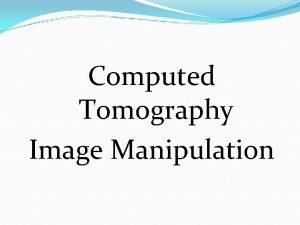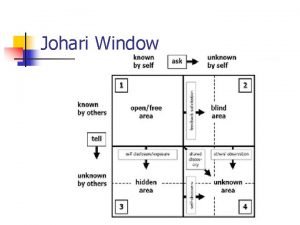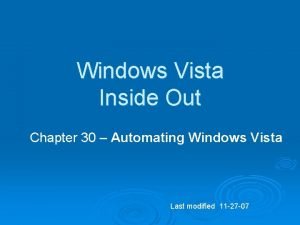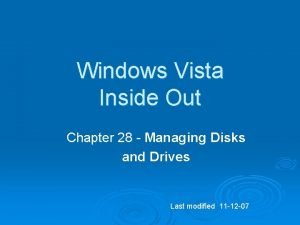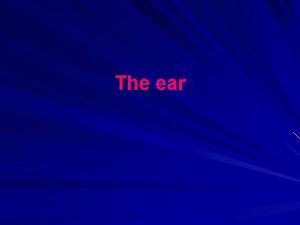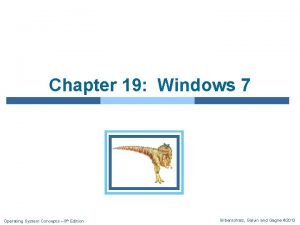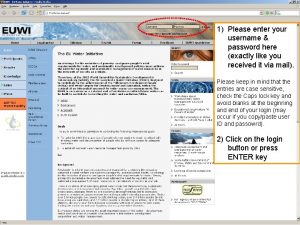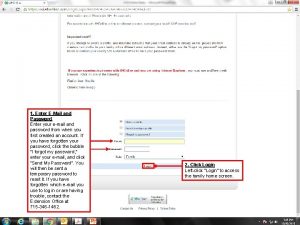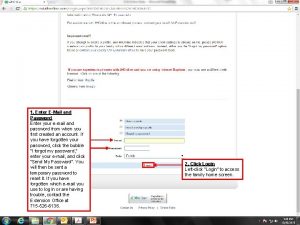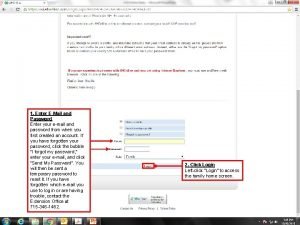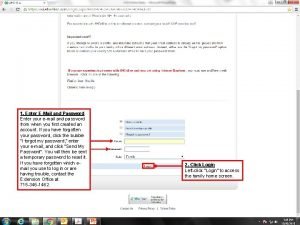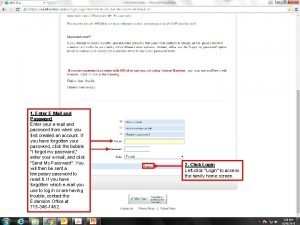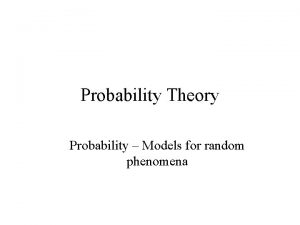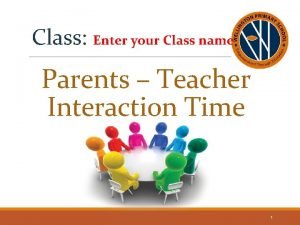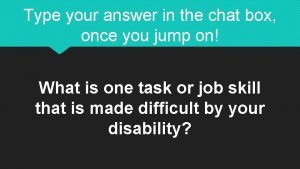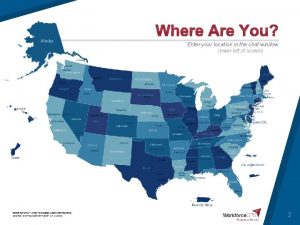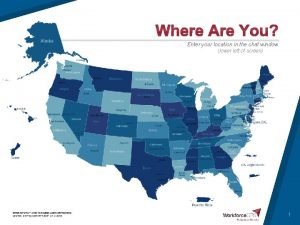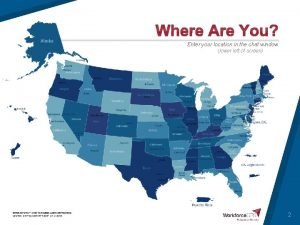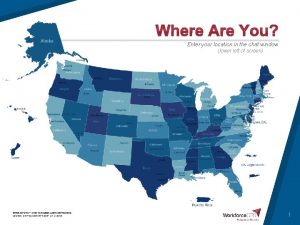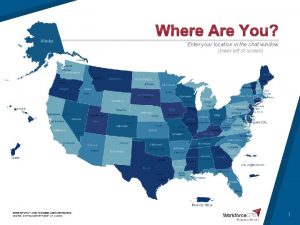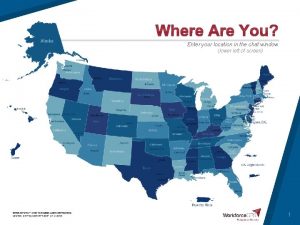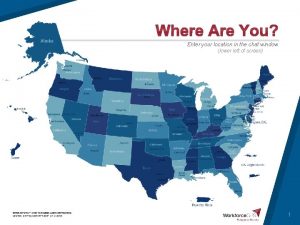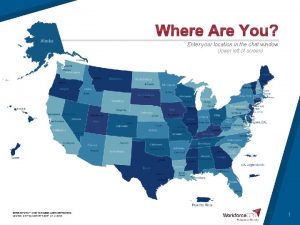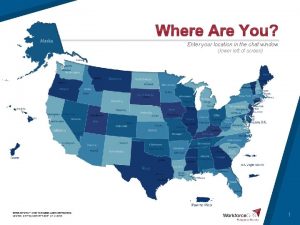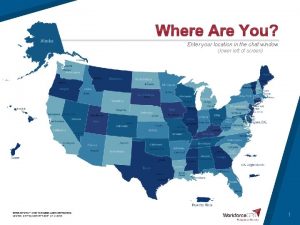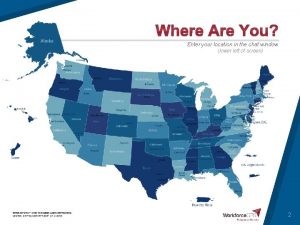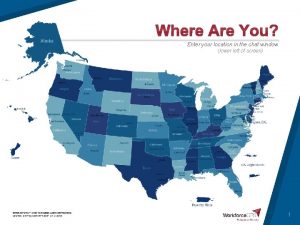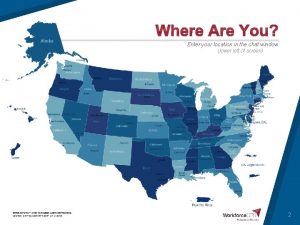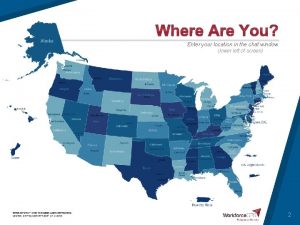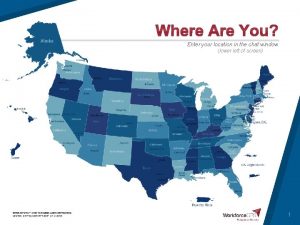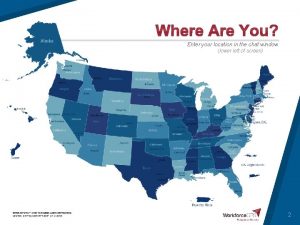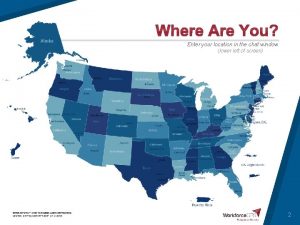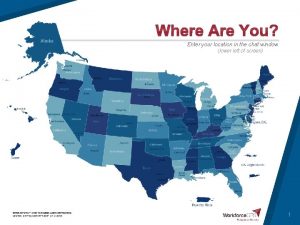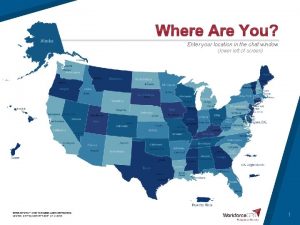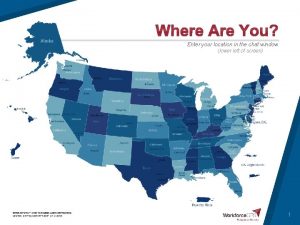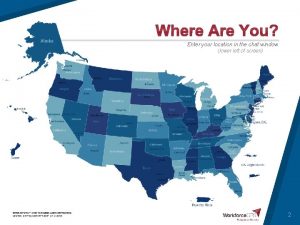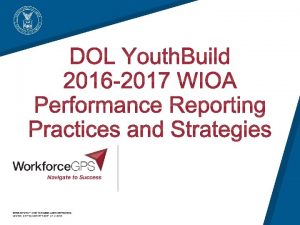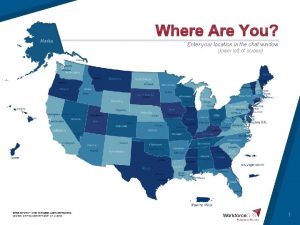Enter your location in the chat window lower




























































- Slides: 60

Enter your location in the chat window (lower left of screen) 1

Let’s get to know who is on the call today. Using the poll, select the organization that you belong to. Choose the answer that best reflects you (or your group): q State Workforce Agency q Workforce Development Board q American Job Center q Training Provider q Service Provider q Other 2

October 18, 2018 Webinar: Thursday, October 18, 2018; 2: 00 p. m. EST

Administrator U. S. Department of Labor, Employment and Training Administration 4

Lead Public Health Advisory, U. S. Department of Health and Human Services, Organization Substance Abuse and Mental Health Services Administration Co-Director of the Addiction Technology Transfer Center (ATTC) Network Coordinating Office (NCO) University of Missouri, Kansas City (UMKC) 5

Associate Director of Substance Use Intervention Youth. Build USA, Inc. Program Director – Youth. Build Austin, Texas American Youth. Works, Inc. 6

Starting the Conversation } Impacts to the Workforce System Understanding the Landscape } Describe the current epidemiology of the opioid crisis Resources to Support Your Community } Explore evidenced-based tools for assessing risk for substance use disorders } Discuss Screening, Brief Intervention and Referral to Treatment (SBIRT) and its application in multiple settings 7

Substance Abuse Disorders and Opioid Misuse Impacts to the Workforce System 8

Choose the answer that best reflects you (or your organization) 1. No, it’s not a problem that I’m aware of. 2. Yes, it’s a problem but it hasn’t impacted my work as a workforce development professional. 3. Yes, it’s a problem and it has somewhat impacted my work as a workforce development professional. 4. Yes, it’s a problem and it has significantly impacted my work as a workforce development professional to the point that my organization is addressing the issue. 9

¡Usually a slow decline, from misuse to abuse ¡Diminished physical and mental health, loss of homes and jobs, social and family separation ¡Road to recovery requires a continuum of care ¡Employment is one key to recovery 10

¡National Safety Council Study } 70% of employers have seen some impact } 20% of employers felt prepared to deal with issues related to addiction } Drug testing limited } Immediate dismissal of employment ¡Many employers are looking for new ways to support their workforce needs. 11

Program Design ¡Extensive orientation and participant screening process ¡Referrals to drug counseling sessions and links to supportive services ¡Develop accelerated training programs for Behavioral Health Counselors 12

Choose the answer that best reflects you (or your organization) 1. What else are you challenged with when serving participants with perceived or known substance use/abuse issues? 13

¡ White House Declaration: National Public Health Emergency ¡ DOL Investments: National Health Emergency Demonstration Projects } Test innovative approaches to address the economic and workforce-related impacts of the opioid epidemic; } Provide training and support activities to dislocated workers (including displaced homemakers), new entrants in the workforce, and incumbent workers, including individuals in these populations who are or have been impacted by the opioid crisis; and, } To provide training that builds the skilled workforce in professions that could impact the causes and treatment of the opioid crisis, including addiction and substance-abuse treatment, mental health, and pain management. ¡ Employers: Federal Bonding Program ¡ Employers: WOTC Tax Credits 14

Facts and Data: The Current Epidemiology of the Opioid Crisis 15

¡ 1. 8 million Americans have an Opioid Use Disorder related to opioid pain killers ¡Opioid-related emergency department visits nearly doubled from 2005 – 2014 ¡Over 625 thousand have a heroin related Opioid Use Disorder ¡Opioid-related inpatient hospital stays increased 64% nationally from 2005 - 2014 16

“There were almost 64, 000 drug overdose deaths in 2016, the largest annual jump ever recorded in the United States, according to the CDC. ” Drug overdose deaths reached 72, 000 in 2017 – CDC 2018 17

1. Strengthening public health surveillance 2. Advancing the practice of pain management 3. Improving access to treatment and recovery services 4. Targeting availability and distribution of overdose reversing drugs 5. Supporting cutting edge research 18

19

Source: U. S. Department of Health and Human Services (HHS), Office of the Surgeon General, Facing Addiction in America: The Surgeon General’s Report on Alcohol, Drugs, and Health. Washington, DC: HHS, November 2016. 20

SUD and Mental Health ¡ 18. 7 million people age 18 or older had a SUD ¡ 8. 5 million 18 or older had both a SUD and mental illness ¡ 46. 6 million people aged 18 or older had a mental illness and 1 in 4 have a Serious Mental Illness (SMI) ¡Serious Mental Illness (SMI) is rising in the 1825 year olds – 2. 6 million ¡Increase in 2016 data in those with SMI receiving treatment – 1. 5 million ¡Leaves @43% not getting treatment 21

Enter your questions in the chat window (lower left of screen) 22

23

¡Well-supported scientific evidence exists for robust predictors (risk and protective factors) of substance use and misuse from birth through adulthood Source: U. S. Department of Health and Human Services (HHS), Office of the Surgeon General, Facing Addiction in America: The Surgeon General’s Report on Alcohol, Drugs, and Health. Washington, DC: HHS, November 2016. 24

Understanding ¡ It can take the brain a long time to return to health following long periods of heavy substance use ¡ Both substance misuse and substance use disorders harm the health and wellbeing of individuals and communities. Addressing them requires implementation of effective strategies Recovery ¡People can and do recover ¡The recovery movement offers a valuable opportunity for people with substance use disorders and their loved ones to get the support 25

Resources ¡ SAMHSA’s Behavioral Health Treatment Services Locator is a confidential and anonymous source of information for persons seeking treatment facilities for substance use disorders or mental health problems ¡ Provider’s Clinical Support System for Medication. Assisted Treatment (PCSS-MAT) is an online national training and mentoring project providing resources on evidence-based practices for addressing the opioid crisis to health professionals at no cost, including free DATA waiver trainings ¡ Addiction Technology Transfer Center (ATTC) is a resource to develop and train providers and create regional training alliances among agencies and organizations that provide substance use disorder treatment and recovery services ¡ Treatment Improvement Protocol (TIP #63): Medications for Opioid Use Disorder Toolkit is a guide to educate providers about assessment and strategies for providing medication-assisted treatment (MAT), pharmacotherapy practices, and supporting ongoing recovery (in development) Resources ¡ Opioid Overdose Prevention Toolkit equips individuals and healthcare providers on ways to prevent and respond to opioid overdose ¡ Clinical Guidance for Treating Pregnant and Parenting Women with Opioid Use Disorder and their Infants describes for providers the appropriate interventions and behavioral/social services to promote the best possible outcome for both mother and child (in development) ¡ A Collaborative Approach to the Treatment of Pregnant Women with Opioid Use Disorder is a manual that offers best practices and MAT for pregnant women living with opioid use disorder (OUD) ¡ Healthy Pregnancy Healthy Baby: Opioids in Pregnancy is a manual for families that addresses the treatment of OUD in pregnancy, postpartum concerns, and neonatal abstinence syndrome (in development) ¡ Neonatal Abstinence Syndrome Technical Expert Panel examined developmental effects related to neonatal exposure to opioids with the goal of identifying research gaps and strategies for practice 26

27

¡Get people help earlier in their course of use ¡Do not wait to “hit rock bottom” 28

¡Naloxone - is a medication designed to rapidly reverse opioid overdose. ¡Safe use – less risk 29

Source: The PEW Charitable Trusts: Medication-Assisted Treatment Improved Outcomes for Patients with Opioid Use Disorder. 2016. http: //attcnetwork. org/userfiles/file/Mid. America/MAT_Improves_Outcomes_OUD. pdf 30

¡Screening Brief Intervention and Referral to Treatment (SBIRT) ¡Comprehensive, integrated, public health approach to the delivery of early intervention and treatment services for persons with substance use disorders, as well as those who are at risk of developing these disorders. 31

Substance Use Prevention & Intervention Patrick L. Mc. Neil, M. Ed. Associate Director of Substance Use Intervention Youth. Build USA, Inc. 32

Youth. Build USA, Inc. ¡Youth. Build USA, Inc. leads a network of 250 domestic Youth. Build programs across America that offer disconnected young people (16 -24) the opportunity to gain education, career, and leadership skills to build a pathway out of poverty. 33

Youth. Build USA, Inc. ¡Youth. Build and other similar job training programs struggle with how to best address substance use/abuse among its participants. 34

Introduction and Context • The majority of YB programs report that substance use/abuse serves as a serious impediment to: 1. Program retention of students; 2. A safety issue on the worksite; 3. Barriers to achieving outcomes in the classroom; 4. Successful post program placement; 35

Substance Use/Abuse in YB • Youth. Build participants that use illicit substances periodically or have a substance use disorder (SUD) are generally masking hidden problems and use the drugs as a “coping” mechanism, most often from childhood trauma; 36

Why are Participants Using? ¡ Coping mechanism ¡ Escape from school and family ¡ To be accepted by their Peers ¡ Family influence/environment ¡ Everybody does it ¡ Curiosity/Just Bored ¡ Pill-popping society ¡ Gang influence ¡ To feel “normal” ¡ Ethnic culture influence 37

Commonly Used Illicit Drugs § Marijuana § Opioids/Pills (Oxycontin, Hydrocodone, Fentanyl, Vicodin, etc. ) § Cocaine § Hallucinogens (LSD, Ketamine, Cough syrup, etc. ) § Methamphetamine § Heroin § Club Drugs (Ecstasy, Mollys, Special K, etc. ) § Other (K-2, SPICE, Inhalants, etc. ) 38

Marijuana Update ¡ With marijuana now legal for “recreational use” in Colorado, Washington, Oregon, Alaska, California, Nevada, Massachusetts, Maine, and Washington D. C. … ¡ Legal for “medical use” in 30 states and Washington DC … and effectively decriminalized in almost every state … ¡ It’s clear that society’s norms and attitudes toward marijuana have changed dramatically. 39

Marijuana Use Messaging ¡ Our goal is to move participants into a career pathway that will offer a living wage and growth potential. If drugs and alcohol are an issue, none of this is possible. We must convey that they will not get hired and/or will lose employment if they consistently fail drug tests or show up to work under the influence of substances. ¡ The legalization of marijuana does not change this! 40

Enter your questions in the chat window (lower left of screen) 41

SBIRT An Evidence Based Prevention and Intervention Strategy 42

What is SBIRT? ¡Screening: routine, universal administration of validated questions to identify potential risks related to alcohol and drug use, followed by positive reinforcement for those who indicate “no current use” at the time of screening. ¡Brief intervention: one or more short, motivational conversations, typically incorporating feedback, advice, and goal-setting around decreasing risk related to sporadic and more-frequent substance use (i. e. , “low” to “moderate” risk). ¡Referral to treatment: the process of connecting individuals with problematic use (“high” risk) to appropriate assessment, treatment, and/or additional services based on their level of need. 43

44

45

SBIRT Results … 46

SBIRT Results … 47

Substance Use Prevention & Intervention David Clauss, LMSW Program Director – Youth. Build Austin, Texas American Youth. Works, Inc. 48

SBIRT in Action … • Started as a literacy program in the 70’s • Became a GED program that incorporated service learning • Youth. Build program, Casa Verde Builders, started in 1994 • Texas Conservation Corps started in 1995 49

SBIRT in Action … Even as we’ve changed and grown, some things remain the same: substance use and abuse by young adults remains a constant. 50

SBIRT in Action … Over the years we’ve tried many different approaches… We evolved to from a zero tolerance, law enforcement attitude to seeing substance abuse through a mental health and harm reduction lens. And then we found SBIRT… 51

SBIRT in Action … Why SBIRT works for Youth. Build It’s all about relationships It’s about keeping it real It’s about what works Keys to success: • Non-judgmental curiosity • Really listening • Giving choices • Build Coping Skills 52

SBIRT in Action … For AYW-Youth. Build Austin SBIRT is part of a comprehensive approach to Positive Youth Development • Trauma-Informed Care • Restorative Justice Practices • Motivational Interviewing • Mindfulness Training 53

Tips for Consideration ¡Change is difficult for almost everyone. It takes some time! ¡Counseling is not possible while someone is high. Under these conditions, only try to manage behavior until the chemical effects have worn off. ¡Stopping the use of drugs is not just about having information and using willpower. Think of how hard people find losing weight despite all the information about the negative effects of being overweight. ¡There is no one approach to solving the problem of substance use. But change is most likely to occur if the client owns their change (intrinsic) and the caseworker is supportive. 54

¡ SAMHSA https: //www. samhsa. gov/ ¡ Surgeon General’s Report https: //addiction. surgeongeneral. gov/ ¡ Addiction Technology Transfer Center – Get specific information on SBIRT http: //attcnetwork. org/national-focusareas/content. aspx? rc=sbirt&content=STCU STOM 2 ¡ Substance Abuse and Mental Health Services Administration. Medications for Opioid Use Disorder https: //store. samhsa. gov/shin/content/SMA 1 8 -5063 FULLDOC/SMA 185063 FULLDOC. pdf ¡ National Survey on Drug Use and Health https: //www. samhsa. gov/data/sites/default/fil es/NSDUH-FFR 1 -2016/NSDUH-FFR 12016. pdf ¡ IRETA – SBIRT specific information https: //ireta. org/? s=SBIRT 55

Enter your questions in the chat window (lower left of screen) 56

Choose the answer that best reflects you (or your organization) 1. We’ve assembled a taskforce(s) in our community to tackle this problem. 2. We’ve identified resources in our community and referring people that need support. 3. We’re providing training services specifically for individuals impacted by this crisis. 4. We’ve developed training programs for behavioral health occupations and peer counselors to tackle this crisis in our community. 57

Co-Director of the Addiction Technology Transfer Center (ATTC) Network Coordinating Office (NCO) ATTC at UMKC hagleh@umkc. edu 412 -478 -5429 Lead Public Health Advisory, U. S. Department of Health and Human Services, SAMHSA reed. forman@samhsa. hhs. gov 240 -276 -2416 58

Associate Director of Substance Use Intervention Youth. Build USA, Inc. pmcneil@youthbuild. org 214. 384. 1618 Program Director – Youth. Build Austin, Texas American Youth. Works, Inc. dclauss@americanyouthworks. org 512. 431. 2605 59

60
 ưu trương
ưu trương Panimulang haka meaning
Panimulang haka meaning Manipulation
Manipulation Window to window mbti
Window to window mbti Windows vista inside out
Windows vista inside out Disk management vista
Disk management vista Mastoid antrum anatomy
Mastoid antrum anatomy Oval window and round window
Oval window and round window Window to window chapter 19
Window to window chapter 19 Please enter your username
Please enter your username Enter your state name
Enter your state name Email and password
Email and password 1 enter your email
1 enter your email Mail @ slidetodoc.com
Mail @ slidetodoc.com 1 enter your email
1 enter your email 1 enter your email
1 enter your email Enter your text here
Enter your text here You and your mom enter a drawing with 3 different prizes
You and your mom enter a drawing with 3 different prizes Company name (optional)
Company name (optional) Augoral
Augoral Type it in the chat box
Type it in the chat box A cross country skier moves from location a to location b
A cross country skier moves from location a to location b Location planning and analysis summary
Location planning and analysis summary Lower your gaze quran
Lower your gaze quran Hayaa
Hayaa Give us your hungry your tired your poor
Give us your hungry your tired your poor Hình ảnh bộ gõ cơ thể búng tay
Hình ảnh bộ gõ cơ thể búng tay Lp html
Lp html Bổ thể
Bổ thể Tỉ lệ cơ thể trẻ em
Tỉ lệ cơ thể trẻ em Voi kéo gỗ như thế nào
Voi kéo gỗ như thế nào Thang điểm glasgow
Thang điểm glasgow Chúa yêu trần thế
Chúa yêu trần thế Môn thể thao bắt đầu bằng chữ f
Môn thể thao bắt đầu bằng chữ f Thế nào là hệ số cao nhất
Thế nào là hệ số cao nhất Các châu lục và đại dương trên thế giới
Các châu lục và đại dương trên thế giới Công thức tiính động năng
Công thức tiính động năng Trời xanh đây là của chúng ta thể thơ
Trời xanh đây là của chúng ta thể thơ Cách giải mật thư tọa độ
Cách giải mật thư tọa độ Làm thế nào để 102-1=99
Làm thế nào để 102-1=99 Phản ứng thế ankan
Phản ứng thế ankan Các châu lục và đại dương trên thế giới
Các châu lục và đại dương trên thế giới Thơ thất ngôn tứ tuyệt đường luật
Thơ thất ngôn tứ tuyệt đường luật Quá trình desamine hóa có thể tạo ra
Quá trình desamine hóa có thể tạo ra Một số thể thơ truyền thống
Một số thể thơ truyền thống Bàn tay mà dây bẩn
Bàn tay mà dây bẩn Vẽ hình chiếu vuông góc của vật thể sau
Vẽ hình chiếu vuông góc của vật thể sau Biện pháp chống mỏi cơ
Biện pháp chống mỏi cơ đặc điểm cơ thể của người tối cổ
đặc điểm cơ thể của người tối cổ Giọng cùng tên là
Giọng cùng tên là Vẽ hình chiếu đứng bằng cạnh của vật thể
Vẽ hình chiếu đứng bằng cạnh của vật thể Fecboak
Fecboak Thẻ vin
Thẻ vin đại từ thay thế
đại từ thay thế điện thế nghỉ
điện thế nghỉ Tư thế ngồi viết
Tư thế ngồi viết Diễn thế sinh thái là
Diễn thế sinh thái là Dot
Dot Số nguyên tố là gì
Số nguyên tố là gì Tư thế ngồi viết
Tư thế ngồi viết Lời thề hippocrates
Lời thề hippocrates


